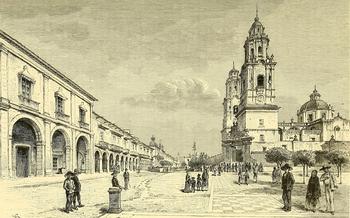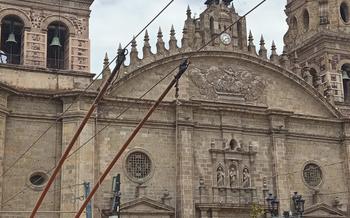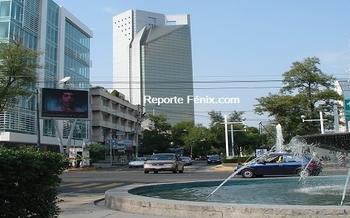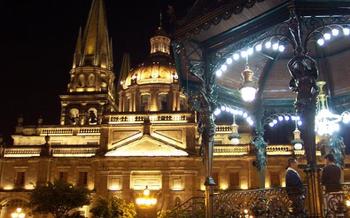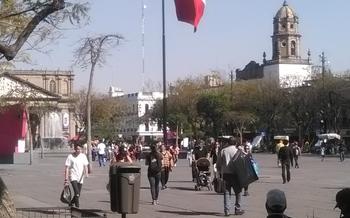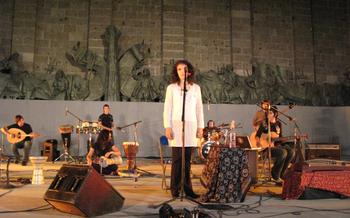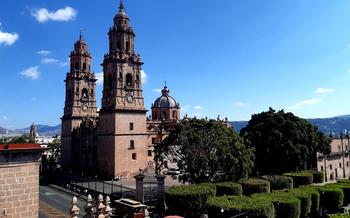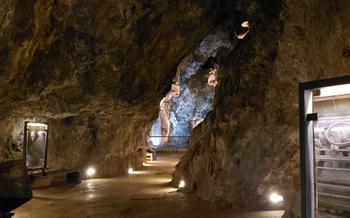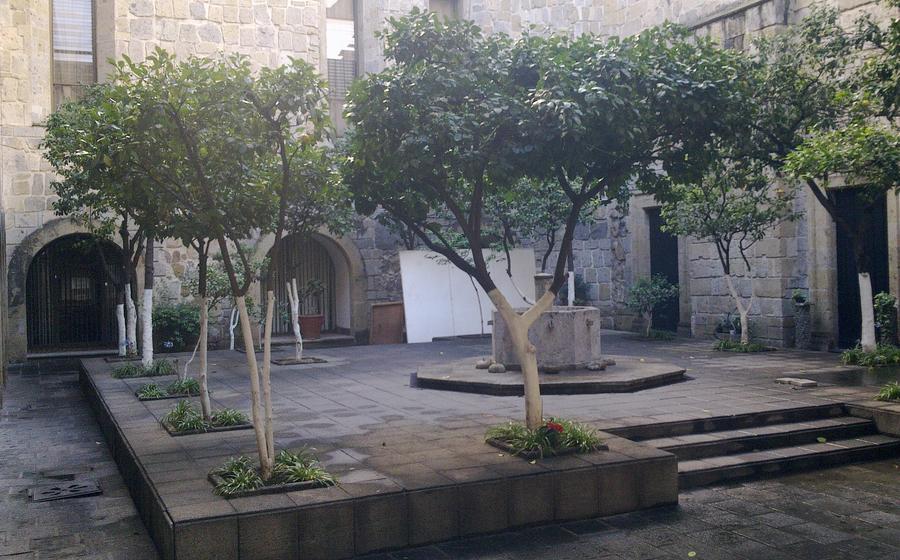
Palacio de Gobierno
- José Clemente Orozco: Master of Social Commentary
- "The Epic of the Mexican People": A Masterpiece of Mexican Art
- Witnessing the Changing of the Guard Ceremony
- Teatro Degollado: A Cultural Gem in Guadalajara
- Hospicio Cabañas: A UNESCO World Heritage Site
- Templo Expiatorio del Santísimo Sacramento: A Neogothic Masterpiece
- Guadalajara's Vibrant Food Scene
- Exploring Guadalajara's Neighborhoods
- Insider Tip: Discovering Hidden Gems
José Clemente Orozco: Master of Social Commentary
José Clemente Orozco, one of Mexico's most renowned muralists, left an indelible mark on the Palacio was marked by poverty and hardship. This experience shaped his artistic vision and led him to become a passionate advocate for social justice and equality.
Orozco's artistic style was characterized by its bold colors, dynamic compositions, and expressive figures. He often depicted scenes of violence, poverty, and oppression, using his art as a means to critique social and political injustices. His work reflected the tumultuous period of the Mexican Revolution and the subsequent social upheaval.
Through his murals, Orozco sought to educate and inspire viewers, encouraging them to question the status quo and fight for a more just and equitable society. His work continues to resonate with audiences worldwide, serving as a powerful reminder of the transformative power of art.
"The Epic of the Mexican People": A Masterpiece of Mexican Art
Overview of the mural's composition and symbolism
"The Epic of the Mexican People" by José Clemente Orozco is an awe-inspiring mural that adorns the walls of the Palacio de Gobierno in Guadalajara. Spanning over 120 feet in length, it is a monumental masterpiece that depicts the history of Mexico from the pre-Columbian era to the Mexican Revolution. Orozco's mural is a visual narrative that weaves together historical events, cultural traditions, and social struggles, creating a powerful and evocative representation of the Mexican people's journey.
The mural is divided into four panels, each representing a distinct period in Mexican history. The first panel portrays the pre-Columbian era, with images of ancient civilizations and their cultural achievements. The second panel depicts the Spanish conquest and colonization, highlighting the clash between indigenous and European cultures. The third panel focuses on the Mexican War of Independence, showcasing the struggle for freedom and self-determination. The final panel culminates with the Mexican Revolution, emphasizing the social and political transformations that shaped modern Mexico.
Throughout the mural, Orozco employs symbolism and allegory to convey complex ideas and emotions. He uses vibrant colors, dynamic compositions, and expressive figures to create a visually stunning and emotionally charged narrative. The mural is not just a historical record but also a powerful commentary on the social and political issues that have shaped Mexico's past and present.
Historical events depicted
Orozco's mural portrays key historical events that have shaped the identity and culture of Mexico. From the arrival of the Spanish conquistadors to the struggle for independence and the Mexican Revolution, the mural chronologically depicts the major turning points in Mexican history.
The pre-Columbian panel features scenes from the ancient civilizations of the Olmecs, Mayans, Aztecs, and other indigenous groups. It highlights their cultural achievements, such as architecture, astronomy, and writing, and emphasizes the rich cultural heritage of Mexico before the arrival of Europeans.
The Spanish conquest and colonization panel depicts the clash between the indigenous peoples and the Spanish colonizers. It portrays the violence and oppression of the colonial regime, as well as the resistance and resilience of the indigenous communities.
The Mexican War of Independence panel celebrates the struggle for freedom and self-determination. It features iconic figures such as Miguel Hidalgo y Costilla and José María Morelos y Pavón, who led the fight against Spanish rule. The panel also depicts the sacrifices and hardships endured by the Mexican people during the long and bloody war.
The Mexican Revolution panel culminates the mural with a powerful representation of the social and political transformations that took place during the early 20th century. It portrays the struggles of the working class, the peasants, and the indigenous communities, as well as the rise of revolutionary leaders such as Emiliano Zapata and Pancho Villa. The panel emphasizes the profound impact of the revolution on Mexican society and its legacy in shaping modern Mexico.
Representation of Mexican identity and culture
"The Epic of the Mexican People" is not just a historical narrative but also a celebration of Mexican identity and culture. Throughout the mural, Orozco highlights the diverse ethnicities, traditions, and customs that make up the rich tapestry of Mexican society.
The mural features portraits of ordinary people, workers, peasants, and indigenous communities, emphasizing their struggles, resilience, and contributions to Mexican history. It also depicts traditional Mexican symbols and iconography, such as the eagle and the serpent, the Virgin of Guadalupe, and the Day of the Dead, showcasing the deep-rooted cultural and religious traditions of Mexico.
Orozco's mural is a powerful testament to the strength, resilience, and cultural richness of the Mexican people. It serves as a reminder of the country's complex history and its ongoing struggle for social justice and equality.
Witnessing the Changing of the Guard Ceremony
One of the most captivating spectacles at the Palacio de Gobierno is the traditional Changing of the Guard ceremony. This solemn and awe-inspiring event takes place every day at 10:00 AM in the courtyard of the palace. Visitors can gather around the grand staircase to witness the precision and discipline of the Jalisco state police force as they execute intricate maneuvers and salute the state flag. The ceremony showcases the rich history and military traditions of Mexico, providing a unique opportunity for visitors to immerse themselves in the cultural heritage of the region.
Teatro Degollado: A Cultural Gem in Guadalajara
Nestled in city's rich cultural heritage. This architectural masterpiece, inaugurated in 1866, boasts a stunning neoclassical façade adorned with intricate reliefs and sculptures. Step inside, and you'll be captivated by the opulent interior, featuring plush red velvet seats, gilded balconies, and a grand chandelier that illuminates the auditorium.
The theater has played a pivotal role in Guadalajara's cultural scene, hosting prestigious performances by renowned artists, musicians, and dancers. Its stage has witnessed countless ballets, operas, concerts, and plays, earning it a reputation as one of Mexico's premier venues for the performing arts.
Beyond its artistic significance, the Teatro Degollado holds historical importance. It served as a gathering place during the 1858 Reform War, where the city's leaders made crucial decisions that shaped the course of Guadalajara's history.
Today, the theater continues to be a vibrant cultural hub, hosting a diverse range of events, including concerts, theater productions, and dance recitals. Guided tours are available, offering visitors a glimpse behind the scenes and a chance to learn about the theater's fascinating history and architecture.
Located on Avenida Hidalgo, in the heart of Guadalajara's historic center, the Teatro Degollado is easily accessible by foot or public transportation. Its central location makes it an ideal starting point for exploring the city's other cultural attractions, such as the Palacio de Gobierno, the Catedral de Guadalajara, and the Hospicio Cabañas.
Hospicio Cabañas: A UNESCO World Heritage Site
Among Guadalajara's cultural landmarks, the Hospicio Cabañas stands out as a UNESCO World Heritage Site, renowned for its architectural significance and stunning murals by José Clemente Orozco. Originally built in the 18th century as an orphanage and shelter, the Hospicio Cabañas showcases a unique blend of Baroque and Neoclassical architecture, featuring a grand courtyard surrounded by arched walkways and intricate domes.
The highlight of the Hospicio Cabañas is undoubtedly Orozco's iconic murals, which adorn the walls of the building's former chapel. These powerful and evocative works of art depict scenes from Mexican history, mythology, and social struggles, showcasing Orozco's mastery of color, composition, and storytelling. The murals have earned widespread acclaim for their artistic merit and their profound exploration of social and political themes.
Today, the Hospicio Cabañas serves as a cultural center and museum, housing a collection of contemporary art exhibits and cultural events. Visitors can explore the building's historic rooms, admire Orozco's murals, and learn about the rich history of this architectural masterpiece. The Hospicio Cabañas stands as a testament to Guadalajara's vibrant arts scene and its commitment to preserving its cultural heritage.
Templo Expiatorio del Santísimo Sacramento: A Neogothic Masterpiece
Guadalajara is home to a stunning architectural gem that transports visitors back to the the city's rich cultural heritage and religious devotion.
Completed in 1972 after nearly a century of construction, the temple is a remarkable example of Neogothic architecture. Its intricate stone carvings, soaring spires, and majestic stained glass windows create an awe-inspiring sight. The facade features intricate sculptures depicting biblical scenes and figures, while the interior is adorned with vibrant murals and decorative elements.
Dedicated to the Blessed Sacrament, the temple serves as a place of worship and pilgrimage for Catholics in the region. Its grand altar, adorned with intricate carvings and precious stones, is a focal point of the interior. The temple's acoustics are renowned for their clarity, making it a popular venue for concerts and religious ceremonies.
Located in the heart of Guadalajara, the Templo Expiatorio del Santísimo Sacramento is easily accessible by foot or public transportation. Visitors can wander through the temple's serene gardens, admiring the lush greenery and tranquil fountains. The temple is an oasis of peace and spirituality in the bustling city, inviting visitors to reflect and connect with their faith.
Guadalajara's Vibrant Food Scene
Guadalajara's culinary landscape is a vibrant tapestry of flavors, aromas, and textures that reflects the city's rich history and cultural heritage. From mouthwatering street food to fine dining establishments, Guadalajara offers a culinary adventure for every palate.
Must-try local dishes and street food:
-
Tortas ahogadas: A Guadalajara specialty, these tortas (sandwiches) are filled with carnitas (slow-cooked pork) and drowned in a spicy tomato sauce.
-
Birria: A traditional stew made with tender goat meat, slowly simmered in a flavorful broth of chiles, spices, and herbs.
-
Pozole: A hearty soup made with hominy, pork or chicken, and a rich broth.
-
Tostadas: Crispy tostadas topped with a variety of ingredients, such as beans, shredded chicken, seafood, or guacamole.
-
Elotes: Grilled corn on the cob, often slathered with mayonnaise, chili powder, and cotija cheese.
Traditional markets and culinary experiences:
-
Mercado Libertad: A bustling market with a vast array of food stalls, where you can sample local delicacies, fresh produce, and traditional candies.
-
Tlaquepaque: A charming neighborhood known for its traditional pottery and vibrant art scene, with many restaurants and cafes offering authentic Mexican cuisine.
-
Tonala: A town just outside Guadalajara, famous for its colorful ceramics and traditional crafts, with a thriving market where you can find unique souvenirs and local culinary delights.
Recommended restaurants and dining districts:
-
Calle López Cotilla: A vibrant street lined with restaurants, bars, and cafes, offering a diverse range of cuisines from traditional Mexican to international flavors.
-
Zona Rosa: A trendy neighborhood with a lively nightlife scene, home to many upscale restaurants and cocktail bars.
-
Chapultepec Avenue: A popular dining destination with a variety of restaurants, from casual cafes to fine dining establishments.
Tips for navigating the local food culture:
-
Embrace street food: Don't be afraid to try the street food vendors, which often offer some of the most delicious and authentic local dishes.
-
Ask for recommendations: Locals are always happy to share their favorite food spots, so don't hesitate to ask for recommendations.
-
Be adventurous: Guadalajara's cuisine is rich in flavors and textures, so be open to trying new dishes and ingredients.
Exploring Guadalajara's Neighborhoods
Guadalajara's neighborhoods offer a diverse range of experiences, from historic districts to charming enclaves with unique attractions and cultural experiences.
-
Explore the Barrio de San Juan de Dios, known for its traditional markets, artisan workshops, and colonial-era architecture.
-
Immerse yourself in the vibrant Colonia Americana, with its Art Deco buildings, trendy cafes, boutiques, and lively nightlife.
-
Discover the Zona Rosa, a vibrant neighborhood known for its LGBTQ+ community, colorful murals, and lively bars.
-
Experience the local culture in the Tonalá neighborhood, famous for its traditional pottery and ceramics, as well as its bustling market.
-
Get lost in the maze-like streets of the Historic Center, admiring the colonial architecture, plazas, and hidden gems.
Tips for Navigating Guadalajara:
- Comfortable shoes are a must, as you'll likely do a lot of walking.
- Take advantage of the city's excellent public transportation system, including buses and the light rail system.
- Be prepared for Guadalajara's diverse climate, which can range from hot and humid to cool and dry.
- Stay alert and aware of your surroundings, especially at night.
Insider Tip: Discovering Hidden Gems
Guadalajara is a city filled with surprises, and there are plenty of hidden gems waiting to be discovered by curious travelers. Venture beyond the main tourist attractions and explore the city's charming neighborhoods, where you'll find hidden plazas, unique street art, and local markets. Take a walk through the historic district of Santa Tere, with its colorful colonial-era buildings and traditional shops. Discover the vibrant street art scene in the Colonia Americana, where artists have transformed walls and buildings into vibrant canvases.
Seek out the hidden culinary treasures in Guadalajara's traditional markets, such as the Mercado de San Juan de Dios, where you can sample local delicacies and find unique ingredients. For an authentic taste of Mexican culture, visit the Tlaquepaque Artisan Market, where you can browse handmade crafts, pottery, and jewelry.
Immerse yourself in the city's vibrant nightlife by exploring the Zona Rosa district, known for its trendy bars, clubs, and live music venues. Experience the local music scene at the Foro Independencia, a concert hall that hosts a variety of performances, from traditional mariachi to contemporary rock bands.
